BSB113 Economics: An Analysis of Traffic Congestion in Brisbane
VerifiedAdded on 2023/06/07
|11
|2035
|261
Essay
AI Summary
This research paper examines the economic and social issues related to traffic congestion in Brisbane, Australia, focusing on its impact on economic efficiency and productivity. It discusses the externalities associated with congestion, highlighting lost productivity due to commute times. The paper uses an economic model to illustrate the relationship between traffic flow and speed, referencing the hypercongestion model. It further explores the economic costs of congestion, including increased emissions, and considers potential solutions such as congestion pricing and public road construction. The analysis also touches upon the effects of congestion on market efficiency and proposes measures implemented in other regions to reduce traffic jams. It concludes that while congestion can sometimes indicate economic growth, its negative impacts often outweigh the benefits.
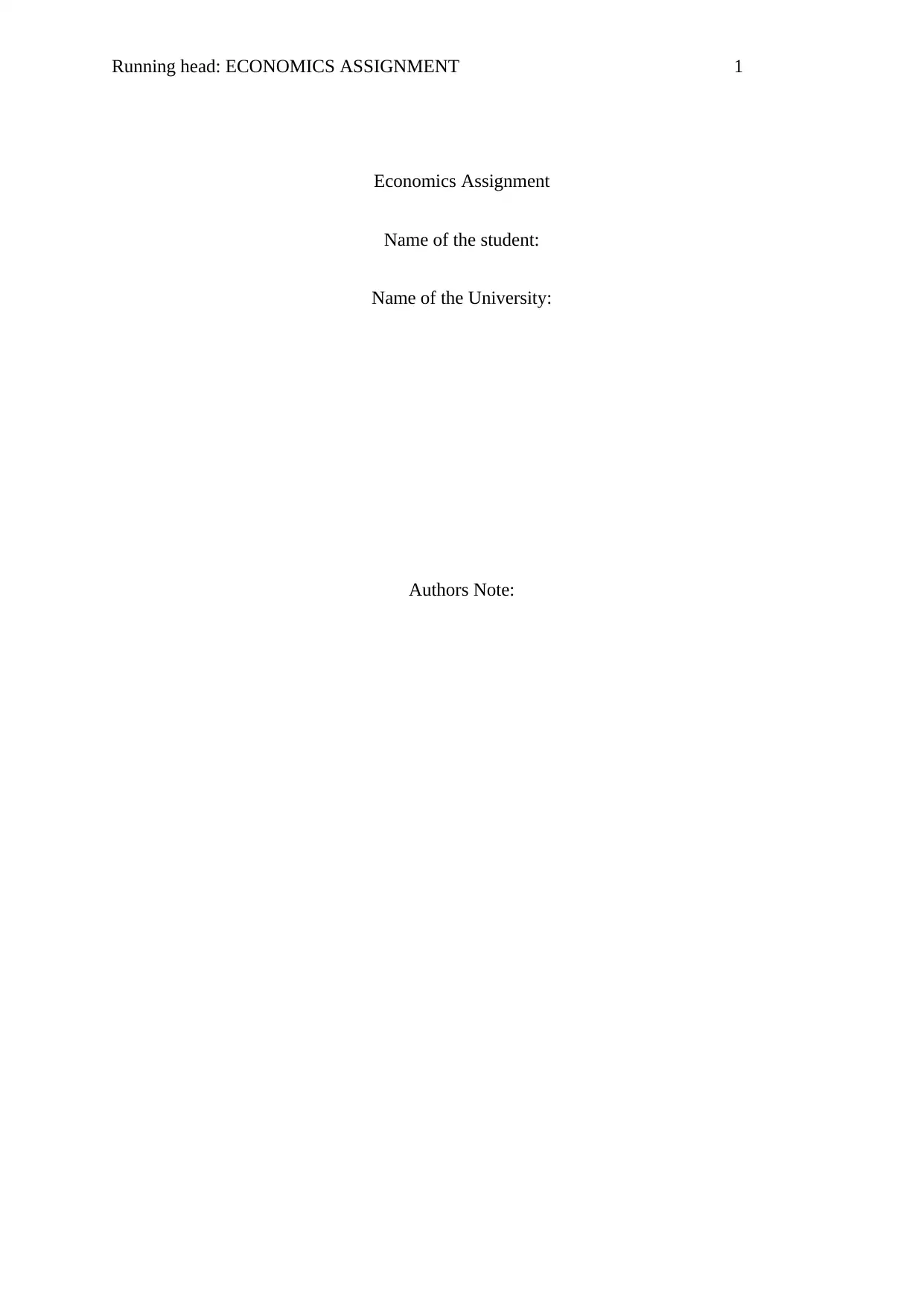
Running head: ECONOMICS ASSIGNMENT 1
Economics Assignment
Name of the student:
Name of the University:
Authors Note:
Economics Assignment
Name of the student:
Name of the University:
Authors Note:
Paraphrase This Document
Need a fresh take? Get an instant paraphrase of this document with our AI Paraphraser
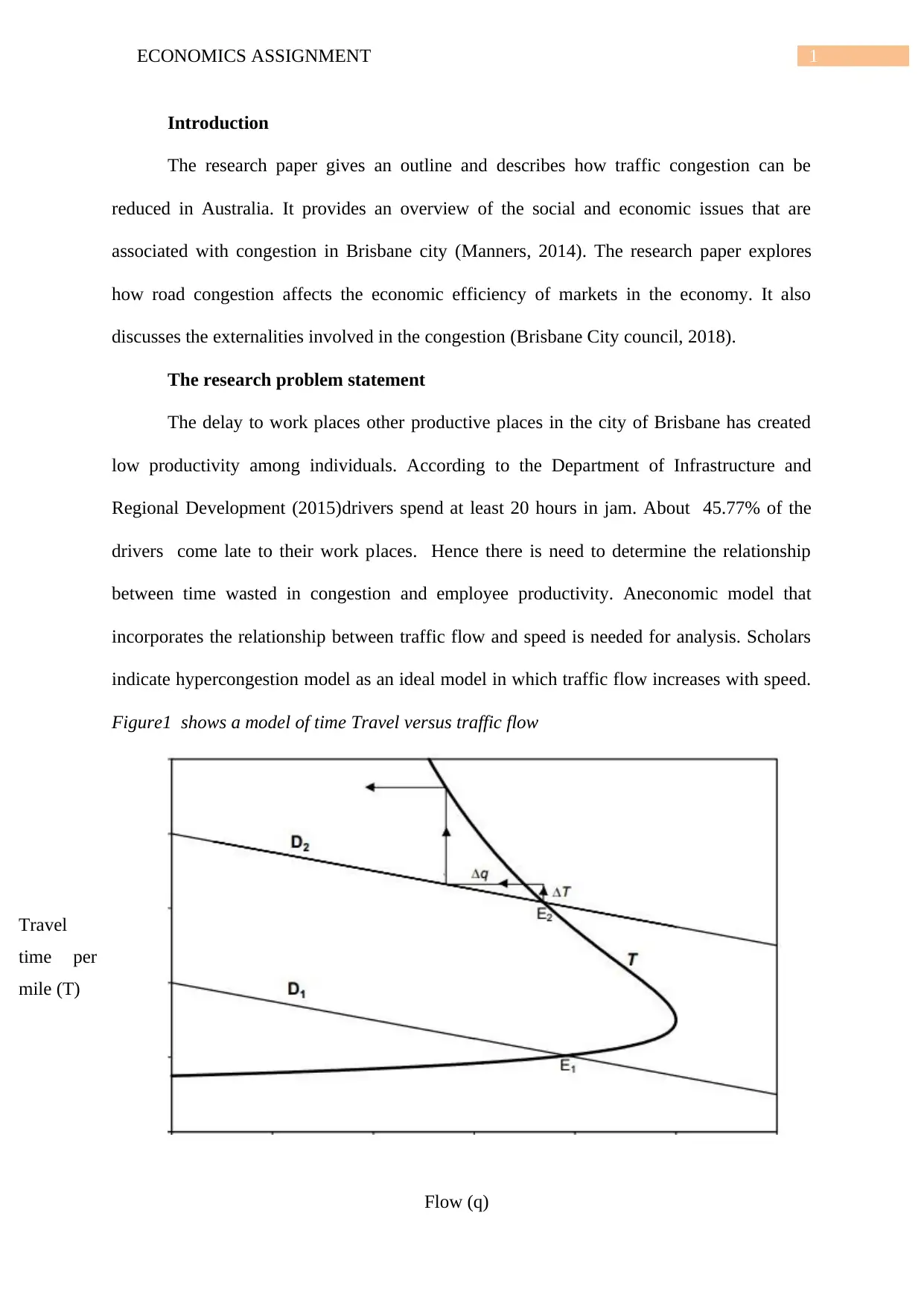
1ECONOMICS ASSIGNMENT
Introduction
The research paper gives an outline and describes how traffic congestion can be
reduced in Australia. It provides an overview of the social and economic issues that are
associated with congestion in Brisbane city (Manners, 2014). The research paper explores
how road congestion affects the economic efficiency of markets in the economy. It also
discusses the externalities involved in the congestion (Brisbane City council, 2018).
The research problem statement
The delay to work places other productive places in the city of Brisbane has created
low productivity among individuals. According to the Department of Infrastructure and
Regional Development (2015)drivers spend at least 20 hours in jam. About 45.77% of the
drivers come late to their work places. Hence there is need to determine the relationship
between time wasted in congestion and employee productivity. Aneconomic model that
incorporates the relationship between traffic flow and speed is needed for analysis. Scholars
indicate hypercongestion model as an ideal model in which traffic flow increases with speed.
Figure1 shows a model of time Travel versus traffic flow
Travel
time per
mile (T)
Flow (q)
Introduction
The research paper gives an outline and describes how traffic congestion can be
reduced in Australia. It provides an overview of the social and economic issues that are
associated with congestion in Brisbane city (Manners, 2014). The research paper explores
how road congestion affects the economic efficiency of markets in the economy. It also
discusses the externalities involved in the congestion (Brisbane City council, 2018).
The research problem statement
The delay to work places other productive places in the city of Brisbane has created
low productivity among individuals. According to the Department of Infrastructure and
Regional Development (2015)drivers spend at least 20 hours in jam. About 45.77% of the
drivers come late to their work places. Hence there is need to determine the relationship
between time wasted in congestion and employee productivity. Aneconomic model that
incorporates the relationship between traffic flow and speed is needed for analysis. Scholars
indicate hypercongestion model as an ideal model in which traffic flow increases with speed.
Figure1 shows a model of time Travel versus traffic flow
Travel
time per
mile (T)
Flow (q)
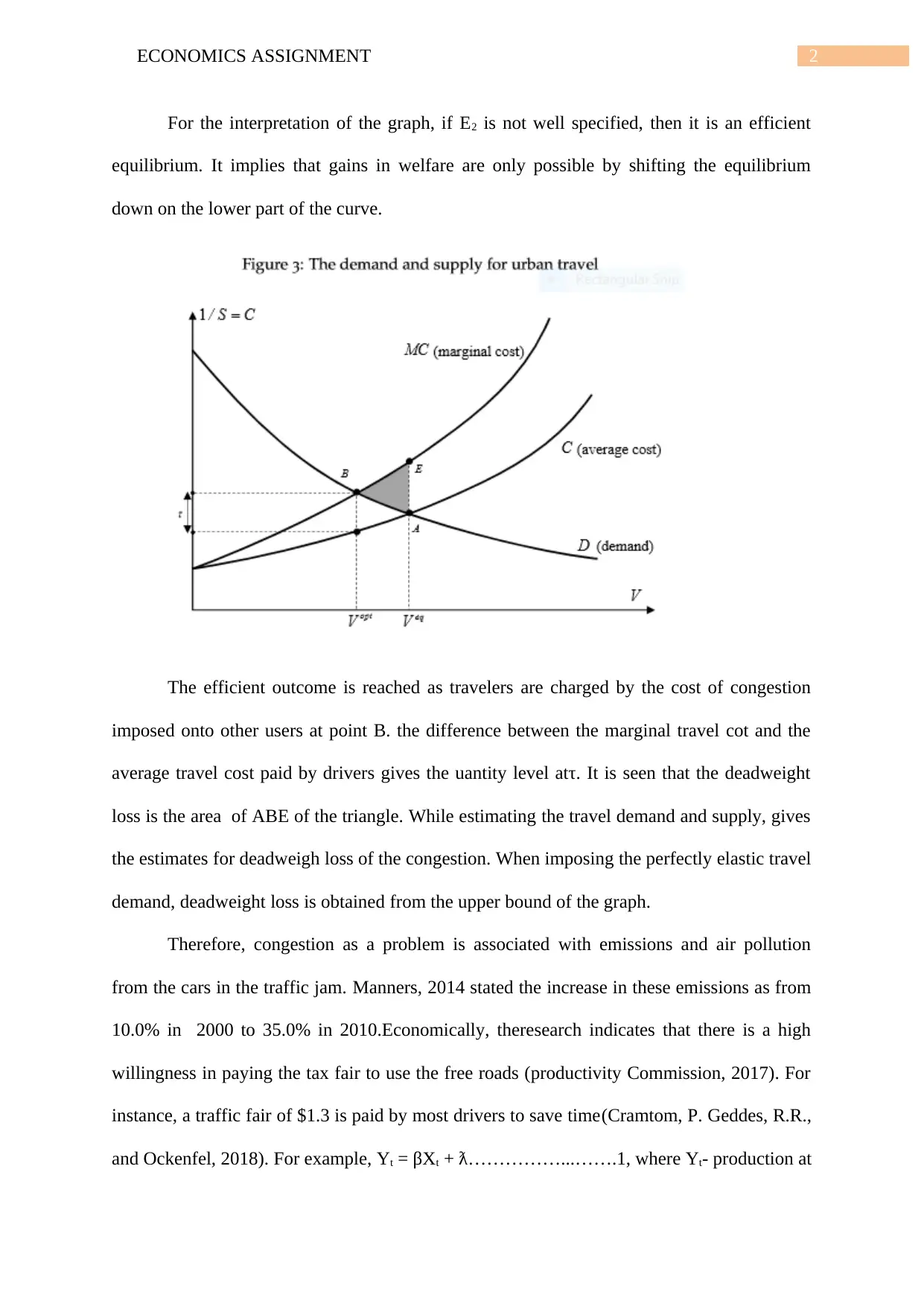
2ECONOMICS ASSIGNMENT
For the interpretation of the graph, if E2 is not well specified, then it is an efficient
equilibrium. It implies that gains in welfare are only possible by shifting the equilibrium
down on the lower part of the curve.
The efficient outcome is reached as travelers are charged by the cost of congestion
imposed onto other users at point B. the difference between the marginal travel cot and the
average travel cost paid by drivers gives the uantity level atτ. It is seen that the deadweight
loss is the area of ABE of the triangle. While estimating the travel demand and supply, gives
the estimates for deadweigh loss of the congestion. When imposing the perfectly elastic travel
demand, deadweight loss is obtained from the upper bound of the graph.
Therefore, congestion as a problem is associated with emissions and air pollution
from the cars in the traffic jam. Manners, 2014 stated the increase in these emissions as from
10.0% in 2000 to 35.0% in 2010.Economically, theresearch indicates that there is a high
willingness in paying the tax fair to use the free roads (productivity Commission, 2017). For
instance, a traffic fair of $1.3 is paid by most drivers to save time(Cramtom, P. Geddes, R.R.,
and Ockenfel, 2018). For example, Yt = βXt + ƛ……………...…….1, where Yt- production at
For the interpretation of the graph, if E2 is not well specified, then it is an efficient
equilibrium. It implies that gains in welfare are only possible by shifting the equilibrium
down on the lower part of the curve.
The efficient outcome is reached as travelers are charged by the cost of congestion
imposed onto other users at point B. the difference between the marginal travel cot and the
average travel cost paid by drivers gives the uantity level atτ. It is seen that the deadweight
loss is the area of ABE of the triangle. While estimating the travel demand and supply, gives
the estimates for deadweigh loss of the congestion. When imposing the perfectly elastic travel
demand, deadweight loss is obtained from the upper bound of the graph.
Therefore, congestion as a problem is associated with emissions and air pollution
from the cars in the traffic jam. Manners, 2014 stated the increase in these emissions as from
10.0% in 2000 to 35.0% in 2010.Economically, theresearch indicates that there is a high
willingness in paying the tax fair to use the free roads (productivity Commission, 2017). For
instance, a traffic fair of $1.3 is paid by most drivers to save time(Cramtom, P. Geddes, R.R.,
and Ockenfel, 2018). For example, Yt = βXt + ƛ……………...…….1, where Yt- production at
⊘ This is a preview!⊘
Do you want full access?
Subscribe today to unlock all pages.

Trusted by 1+ million students worldwide
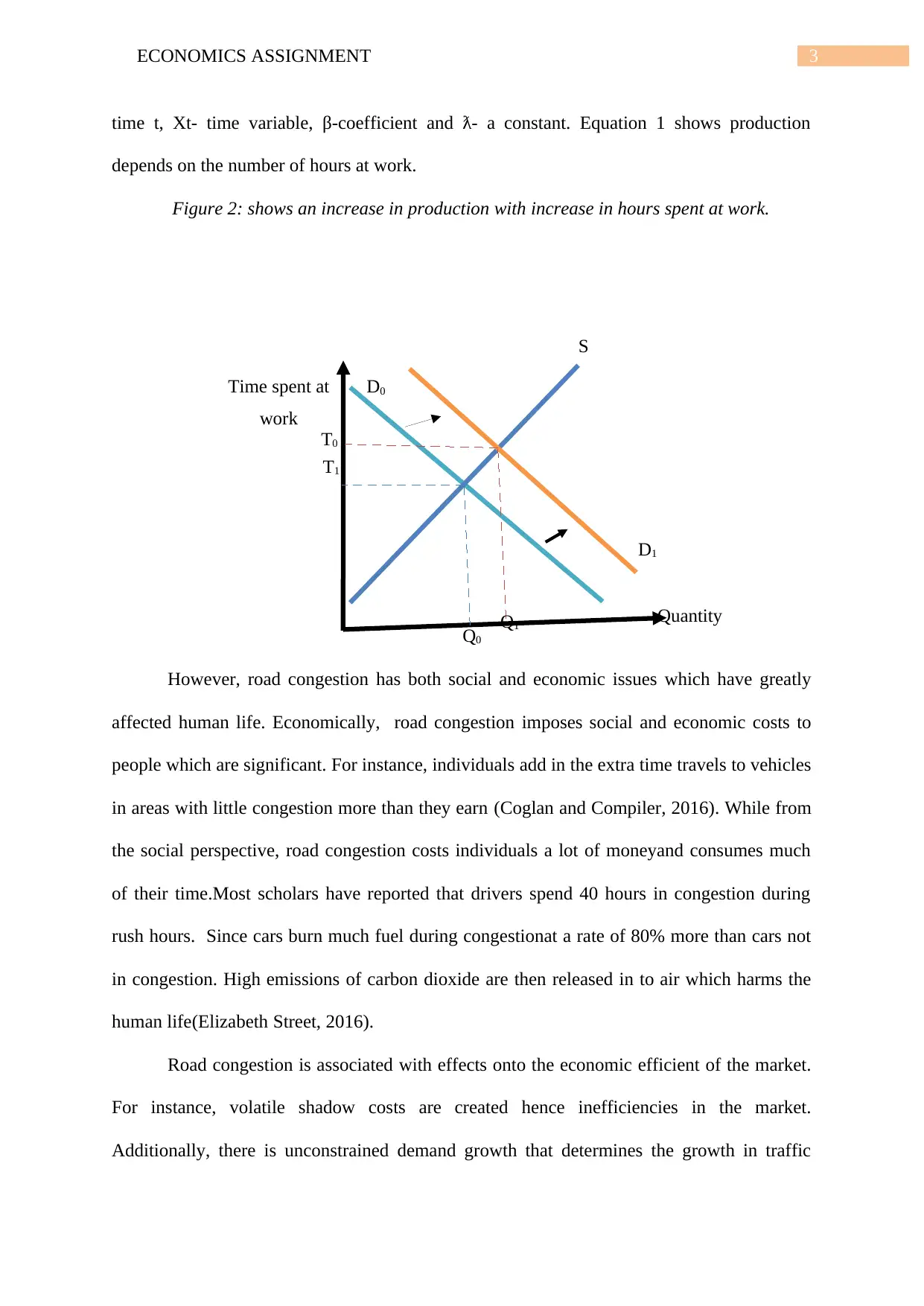
3ECONOMICS ASSIGNMENT
time t, Xt- time variable, β-coefficient and ƛ- a constant. Equation 1 shows production
depends on the number of hours at work.
Figure 2: shows an increase in production with increase in hours spent at work.
However, road congestion has both social and economic issues which have greatly
affected human life. Economically, road congestion imposes social and economic costs to
people which are significant. For instance, individuals add in the extra time travels to vehicles
in areas with little congestion more than they earn (Coglan and Compiler, 2016). While from
the social perspective, road congestion costs individuals a lot of moneyand consumes much
of their time.Most scholars have reported that drivers spend 40 hours in congestion during
rush hours. Since cars burn much fuel during congestionat a rate of 80% more than cars not
in congestion. High emissions of carbon dioxide are then released in to air which harms the
human life(Elizabeth Street, 2016).
Road congestion is associated with effects onto the economic efficient of the market.
For instance, volatile shadow costs are created hence inefficiencies in the market.
Additionally, there is unconstrained demand growth that determines the growth in traffic
Quantity
Time spent at
work
S
D0
D1
Q0
Q1
T0
T1
time t, Xt- time variable, β-coefficient and ƛ- a constant. Equation 1 shows production
depends on the number of hours at work.
Figure 2: shows an increase in production with increase in hours spent at work.
However, road congestion has both social and economic issues which have greatly
affected human life. Economically, road congestion imposes social and economic costs to
people which are significant. For instance, individuals add in the extra time travels to vehicles
in areas with little congestion more than they earn (Coglan and Compiler, 2016). While from
the social perspective, road congestion costs individuals a lot of moneyand consumes much
of their time.Most scholars have reported that drivers spend 40 hours in congestion during
rush hours. Since cars burn much fuel during congestionat a rate of 80% more than cars not
in congestion. High emissions of carbon dioxide are then released in to air which harms the
human life(Elizabeth Street, 2016).
Road congestion is associated with effects onto the economic efficient of the market.
For instance, volatile shadow costs are created hence inefficiencies in the market.
Additionally, there is unconstrained demand growth that determines the growth in traffic
Quantity
Time spent at
work
S
D0
D1
Q0
Q1
T0
T1
Paraphrase This Document
Need a fresh take? Get an instant paraphrase of this document with our AI Paraphraser
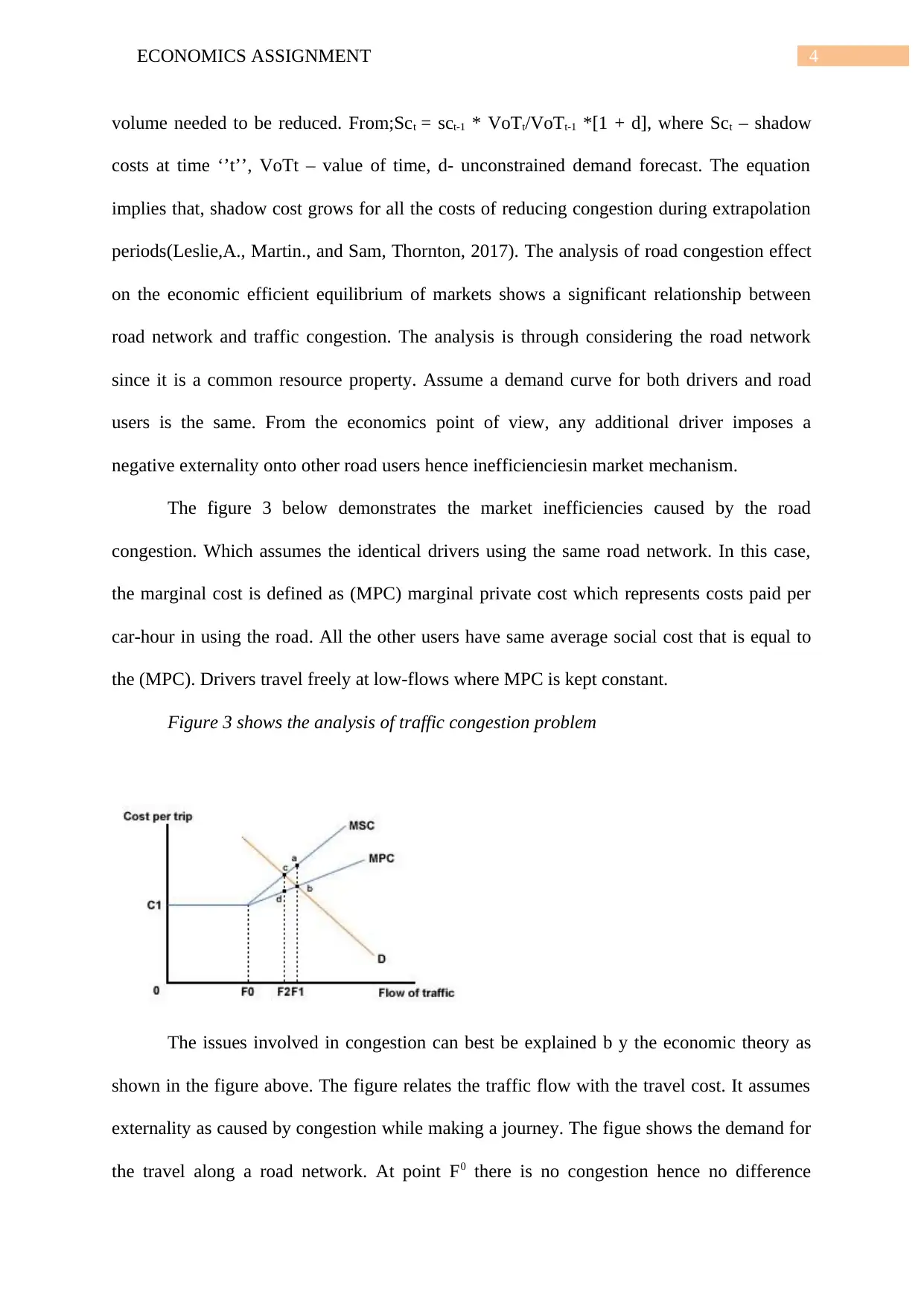
4ECONOMICS ASSIGNMENT
volume needed to be reduced. From;Sct = sct-1 * VoTt/VoTt-1 *[1 + d], where Sct – shadow
costs at time ‘’t’’, VoTt – value of time, d- unconstrained demand forecast. The equation
implies that, shadow cost grows for all the costs of reducing congestion during extrapolation
periods(Leslie,A., Martin., and Sam, Thornton, 2017). The analysis of road congestion effect
on the economic efficient equilibrium of markets shows a significant relationship between
road network and traffic congestion. The analysis is through considering the road network
since it is a common resource property. Assume a demand curve for both drivers and road
users is the same. From the economics point of view, any additional driver imposes a
negative externality onto other road users hence inefficienciesin market mechanism.
The figure 3 below demonstrates the market inefficiencies caused by the road
congestion. Which assumes the identical drivers using the same road network. In this case,
the marginal cost is defined as (MPC) marginal private cost which represents costs paid per
car-hour in using the road. All the other users have same average social cost that is equal to
the (MPC). Drivers travel freely at low-flows where MPC is kept constant.
Figure 3 shows the analysis of traffic congestion problem
The issues involved in congestion can best be explained b y the economic theory as
shown in the figure above. The figure relates the traffic flow with the travel cost. It assumes
externality as caused by congestion while making a journey. The figue shows the demand for
the travel along a road network. At point F0 there is no congestion hence no difference
volume needed to be reduced. From;Sct = sct-1 * VoTt/VoTt-1 *[1 + d], where Sct – shadow
costs at time ‘’t’’, VoTt – value of time, d- unconstrained demand forecast. The equation
implies that, shadow cost grows for all the costs of reducing congestion during extrapolation
periods(Leslie,A., Martin., and Sam, Thornton, 2017). The analysis of road congestion effect
on the economic efficient equilibrium of markets shows a significant relationship between
road network and traffic congestion. The analysis is through considering the road network
since it is a common resource property. Assume a demand curve for both drivers and road
users is the same. From the economics point of view, any additional driver imposes a
negative externality onto other road users hence inefficienciesin market mechanism.
The figure 3 below demonstrates the market inefficiencies caused by the road
congestion. Which assumes the identical drivers using the same road network. In this case,
the marginal cost is defined as (MPC) marginal private cost which represents costs paid per
car-hour in using the road. All the other users have same average social cost that is equal to
the (MPC). Drivers travel freely at low-flows where MPC is kept constant.
Figure 3 shows the analysis of traffic congestion problem
The issues involved in congestion can best be explained b y the economic theory as
shown in the figure above. The figure relates the traffic flow with the travel cost. It assumes
externality as caused by congestion while making a journey. The figue shows the demand for
the travel along a road network. At point F0 there is no congestion hence no difference
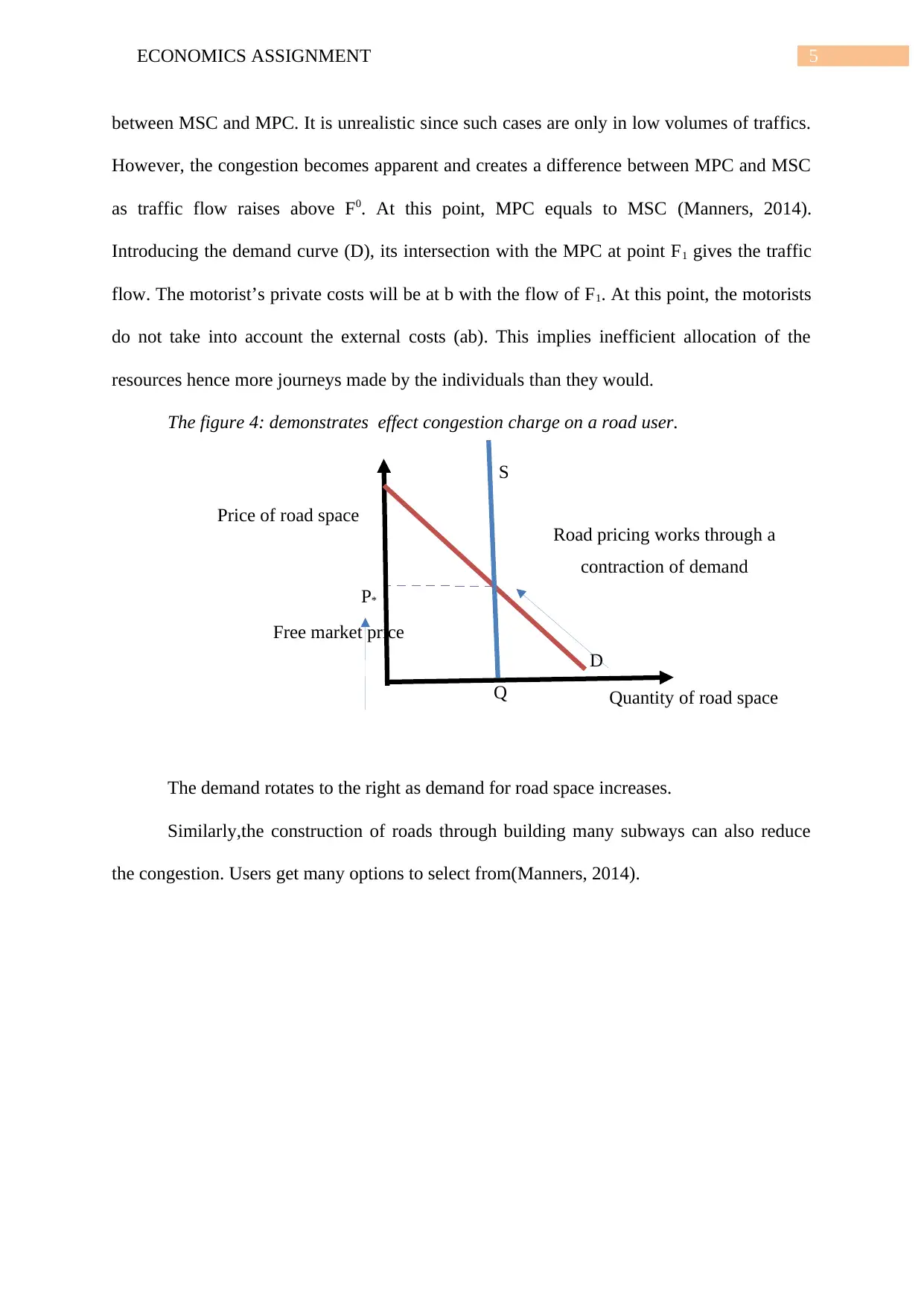
5ECONOMICS ASSIGNMENT
between MSC and MPC. It is unrealistic since such cases are only in low volumes of traffics.
However, the congestion becomes apparent and creates a difference between MPC and MSC
as traffic flow raises above F0. At this point, MPC equals to MSC (Manners, 2014).
Introducing the demand curve (D), its intersection with the MPC at point F1 gives the traffic
flow. The motorist’s private costs will be at b with the flow of F1. At this point, the motorists
do not take into account the external costs (ab). This implies inefficient allocation of the
resources hence more journeys made by the individuals than they would.
The figure 4: demonstrates effect congestion charge on a road user.
The demand rotates to the right as demand for road space increases.
Similarly,the construction of roads through building many subways can also reduce
the congestion. Users get many options to select from(Manners, 2014).
Free market price
Road pricing works through a
contraction of demand
Quantity of road space
Price of road space
P*
D
Q
S
between MSC and MPC. It is unrealistic since such cases are only in low volumes of traffics.
However, the congestion becomes apparent and creates a difference between MPC and MSC
as traffic flow raises above F0. At this point, MPC equals to MSC (Manners, 2014).
Introducing the demand curve (D), its intersection with the MPC at point F1 gives the traffic
flow. The motorist’s private costs will be at b with the flow of F1. At this point, the motorists
do not take into account the external costs (ab). This implies inefficient allocation of the
resources hence more journeys made by the individuals than they would.
The figure 4: demonstrates effect congestion charge on a road user.
The demand rotates to the right as demand for road space increases.
Similarly,the construction of roads through building many subways can also reduce
the congestion. Users get many options to select from(Manners, 2014).
Free market price
Road pricing works through a
contraction of demand
Quantity of road space
Price of road space
P*
D
Q
S
⊘ This is a preview!⊘
Do you want full access?
Subscribe today to unlock all pages.

Trusted by 1+ million students worldwide
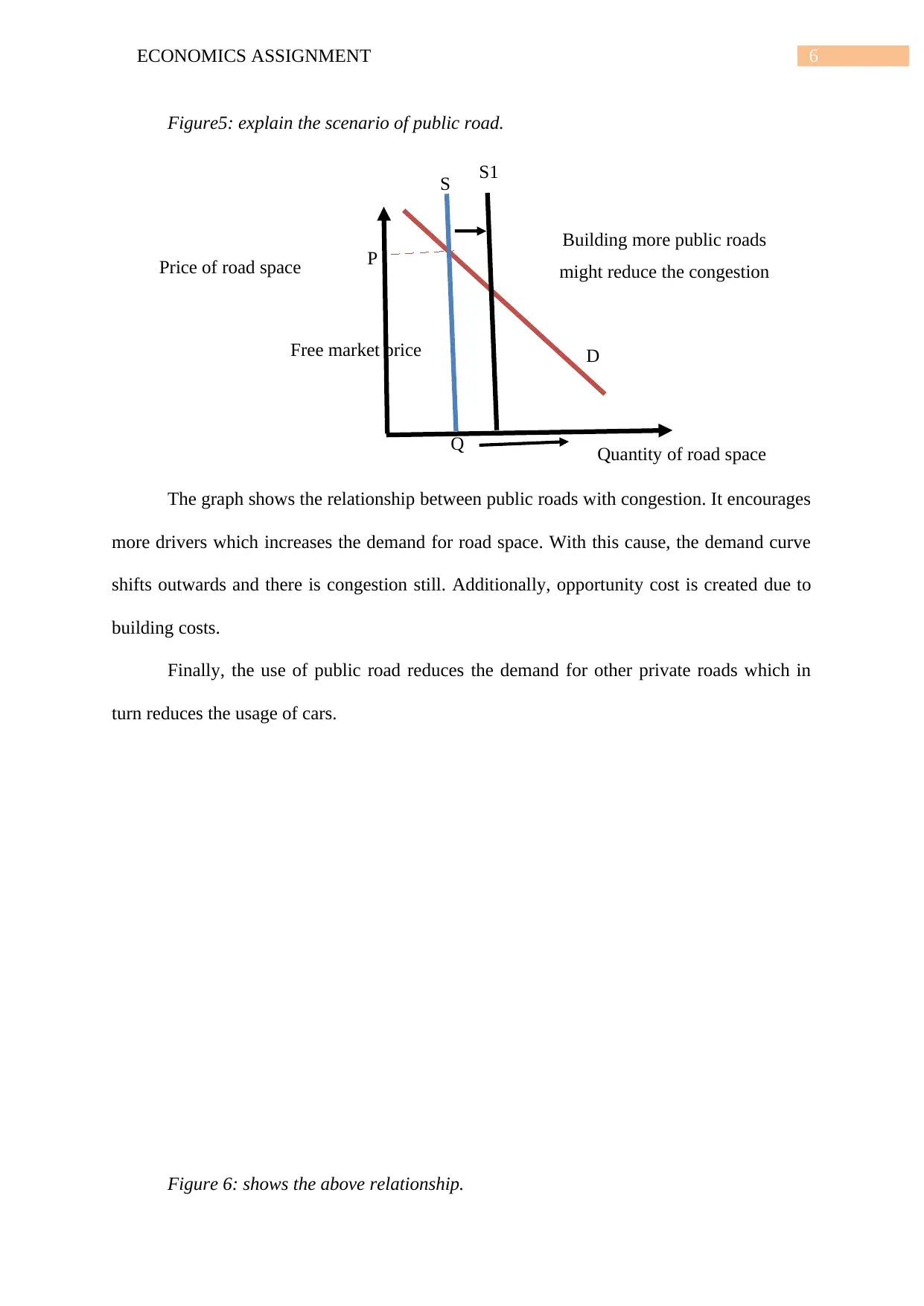
6ECONOMICS ASSIGNMENT
Figure5: explain the scenario of public road.
The graph shows the relationship between public roads with congestion. It encourages
more drivers which increases the demand for road space. With this cause, the demand curve
shifts outwards and there is congestion still. Additionally, opportunity cost is created due to
building costs.
Finally, the use of public road reduces the demand for other private roads which in
turn reduces the usage of cars.
Figure 6: shows the above relationship.
Free market price
Building more public roads
might reduce the congestion
Quantity of road space
Price of road space P
D
Q
S1
S
0
Figure5: explain the scenario of public road.
The graph shows the relationship between public roads with congestion. It encourages
more drivers which increases the demand for road space. With this cause, the demand curve
shifts outwards and there is congestion still. Additionally, opportunity cost is created due to
building costs.
Finally, the use of public road reduces the demand for other private roads which in
turn reduces the usage of cars.
Figure 6: shows the above relationship.
Free market price
Building more public roads
might reduce the congestion
Quantity of road space
Price of road space P
D
Q
S1
S
0
Paraphrase This Document
Need a fresh take? Get an instant paraphrase of this document with our AI Paraphraser
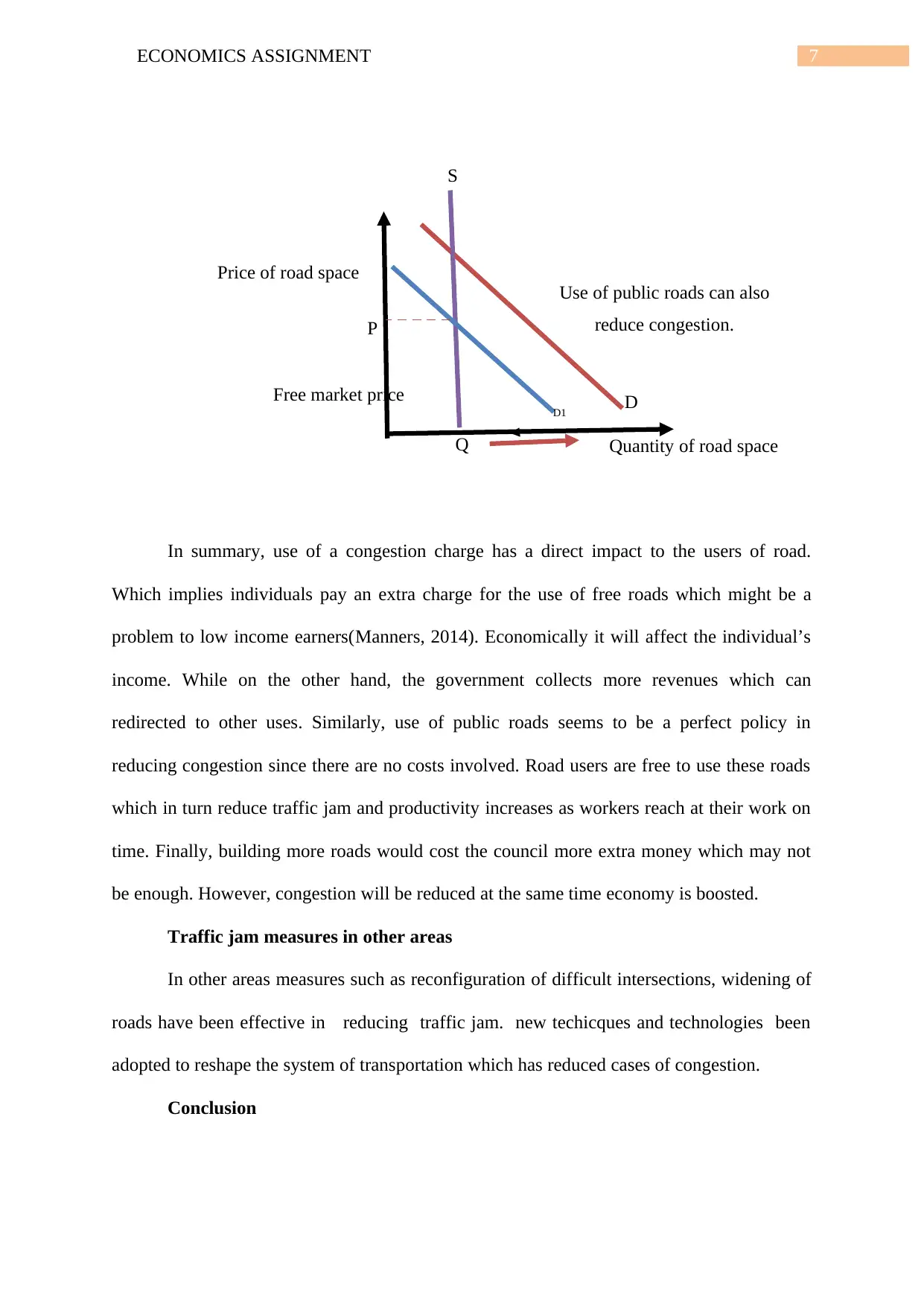
7ECONOMICS ASSIGNMENT
In summary, use of a congestion charge has a direct impact to the users of road.
Which implies individuals pay an extra charge for the use of free roads which might be a
problem to low income earners(Manners, 2014). Economically it will affect the individual’s
income. While on the other hand, the government collects more revenues which can
redirected to other uses. Similarly, use of public roads seems to be a perfect policy in
reducing congestion since there are no costs involved. Road users are free to use these roads
which in turn reduce traffic jam and productivity increases as workers reach at their work on
time. Finally, building more roads would cost the council more extra money which may not
be enough. However, congestion will be reduced at the same time economy is boosted.
Traffic jam measures in other areas
In other areas measures such as reconfiguration of difficult intersections, widening of
roads have been effective in reducing traffic jam. new techicques and technologies been
adopted to reshape the system of transportation which has reduced cases of congestion.
Conclusion
Free market price
Use of public roads can also
reduce congestion.
Quantity of road space
Price of road space
P
D
Q
S
D1
1A
In summary, use of a congestion charge has a direct impact to the users of road.
Which implies individuals pay an extra charge for the use of free roads which might be a
problem to low income earners(Manners, 2014). Economically it will affect the individual’s
income. While on the other hand, the government collects more revenues which can
redirected to other uses. Similarly, use of public roads seems to be a perfect policy in
reducing congestion since there are no costs involved. Road users are free to use these roads
which in turn reduce traffic jam and productivity increases as workers reach at their work on
time. Finally, building more roads would cost the council more extra money which may not
be enough. However, congestion will be reduced at the same time economy is boosted.
Traffic jam measures in other areas
In other areas measures such as reconfiguration of difficult intersections, widening of
roads have been effective in reducing traffic jam. new techicques and technologies been
adopted to reshape the system of transportation which has reduced cases of congestion.
Conclusion
Free market price
Use of public roads can also
reduce congestion.
Quantity of road space
Price of road space
P
D
Q
S
D1
1A
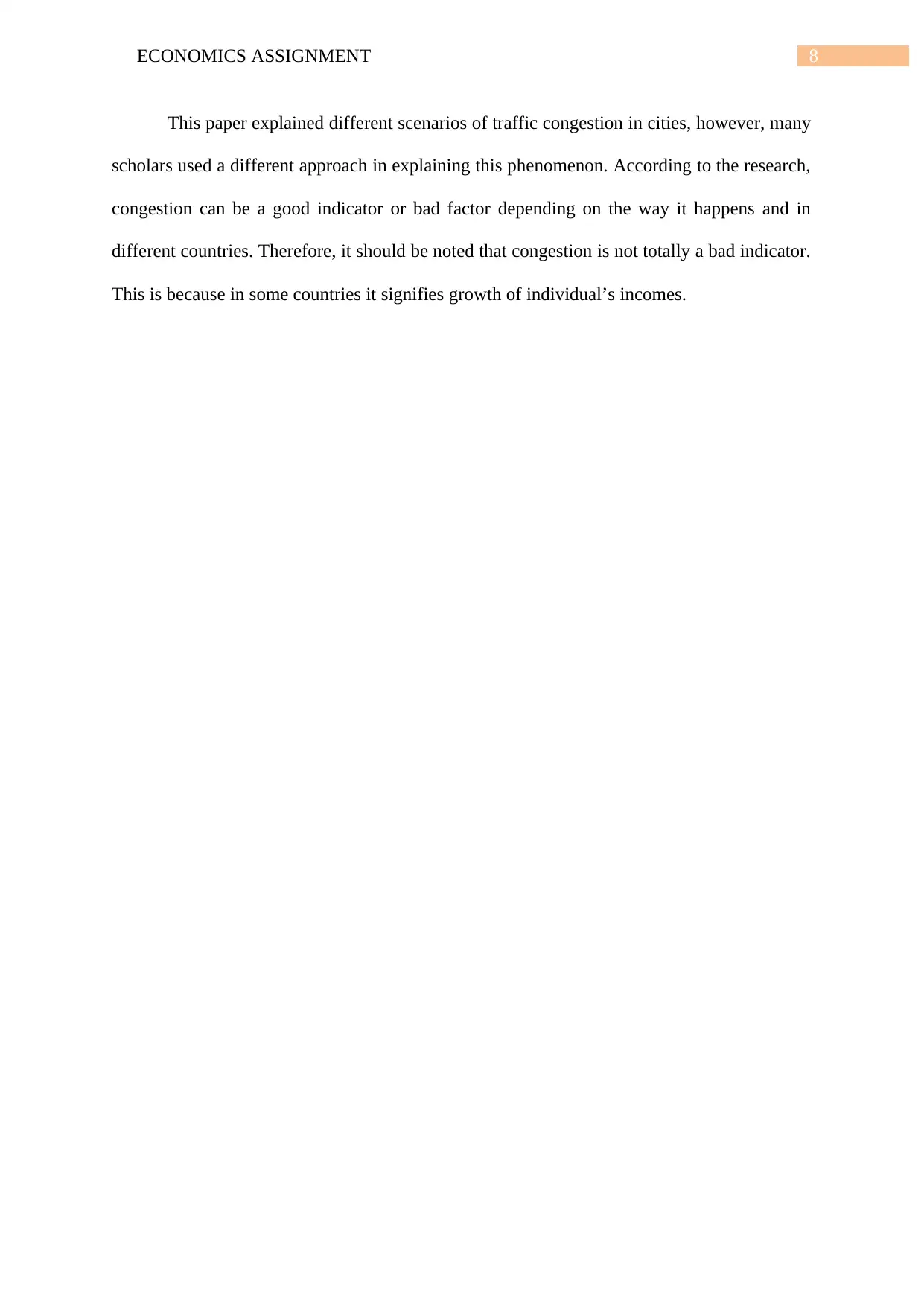
8ECONOMICS ASSIGNMENT
This paper explained different scenarios of traffic congestion in cities, however, many
scholars used a different approach in explaining this phenomenon. According to the research,
congestion can be a good indicator or bad factor depending on the way it happens and in
different countries. Therefore, it should be noted that congestion is not totally a bad indicator.
This is because in some countries it signifies growth of individual’s incomes.
This paper explained different scenarios of traffic congestion in cities, however, many
scholars used a different approach in explaining this phenomenon. According to the research,
congestion can be a good indicator or bad factor depending on the way it happens and in
different countries. Therefore, it should be noted that congestion is not totally a bad indicator.
This is because in some countries it signifies growth of individual’s incomes.
⊘ This is a preview!⊘
Do you want full access?
Subscribe today to unlock all pages.

Trusted by 1+ million students worldwide
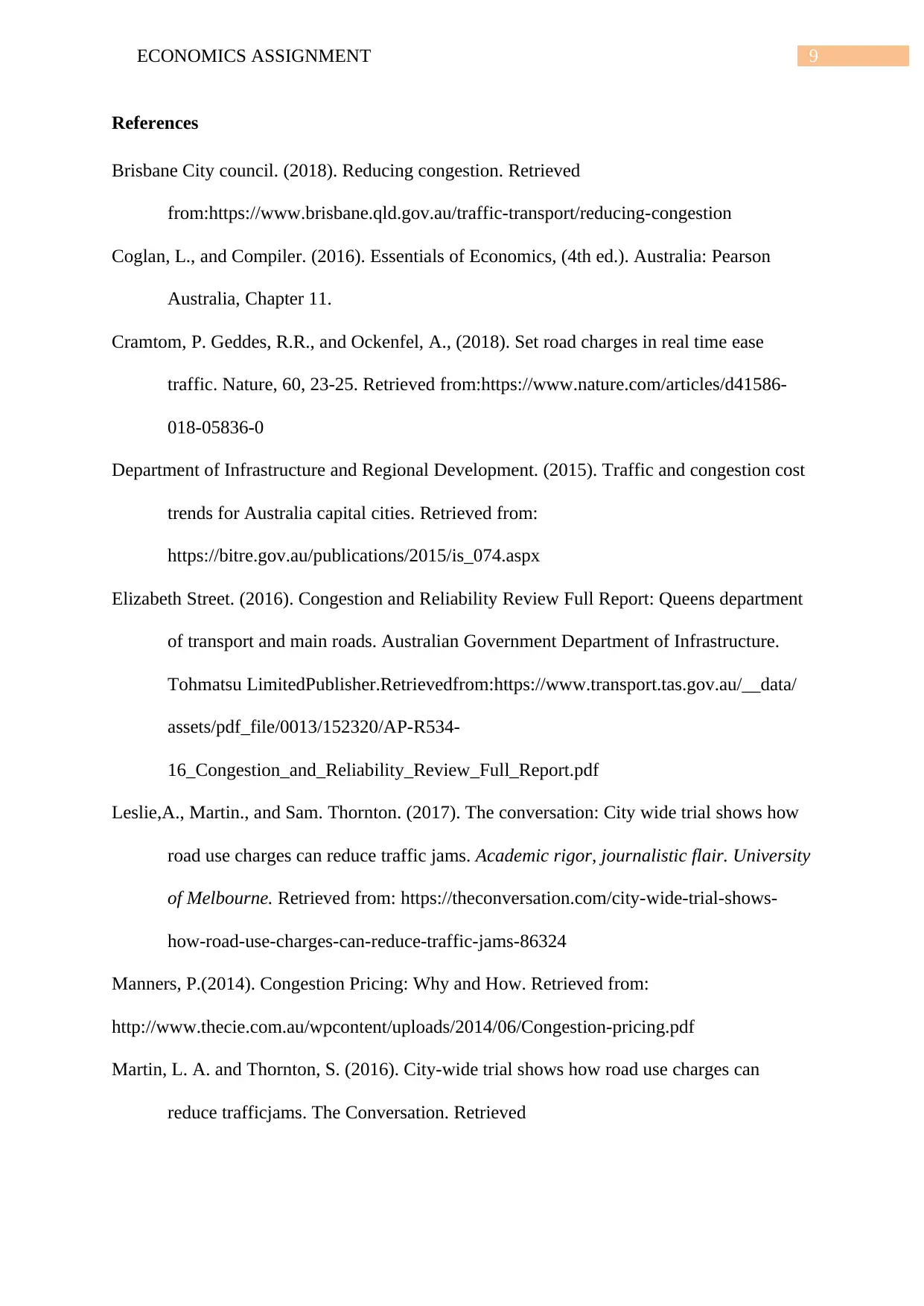
9ECONOMICS ASSIGNMENT
References
Brisbane City council. (2018). Reducing congestion. Retrieved
from:https://www.brisbane.qld.gov.au/traffic-transport/reducing-congestion
Coglan, L., and Compiler. (2016). Essentials of Economics, (4th ed.). Australia: Pearson
Australia, Chapter 11.
Cramtom, P. Geddes, R.R., and Ockenfel, A., (2018). Set road charges in real time ease
traffic. Nature, 60, 23-25. Retrieved from:https://www.nature.com/articles/d41586-
018-05836-0
Department of Infrastructure and Regional Development. (2015). Traffic and congestion cost
trends for Australia capital cities. Retrieved from:
https://bitre.gov.au/publications/2015/is_074.aspx
Elizabeth Street. (2016). Congestion and Reliability Review Full Report: Queens department
of transport and main roads. Australian Government Department of Infrastructure.
Tohmatsu LimitedPublisher.Retrievedfrom:https://www.transport.tas.gov.au/__data/
assets/pdf_file/0013/152320/AP-R534-
16_Congestion_and_Reliability_Review_Full_Report.pdf
Leslie,A., Martin., and Sam. Thornton. (2017). The conversation: City wide trial shows how
road use charges can reduce traffic jams. Academic rigor, journalistic flair. University
of Melbourne. Retrieved from: https://theconversation.com/city-wide-trial-shows-
how-road-use-charges-can-reduce-traffic-jams-86324
Manners, P.(2014). Congestion Pricing: Why and How. Retrieved from:
http://www.thecie.com.au/wpcontent/uploads/2014/06/Congestion-pricing.pdf
Martin, L. A. and Thornton, S. (2016). City-wide trial shows how road use charges can
reduce trafficjams. The Conversation. Retrieved
References
Brisbane City council. (2018). Reducing congestion. Retrieved
from:https://www.brisbane.qld.gov.au/traffic-transport/reducing-congestion
Coglan, L., and Compiler. (2016). Essentials of Economics, (4th ed.). Australia: Pearson
Australia, Chapter 11.
Cramtom, P. Geddes, R.R., and Ockenfel, A., (2018). Set road charges in real time ease
traffic. Nature, 60, 23-25. Retrieved from:https://www.nature.com/articles/d41586-
018-05836-0
Department of Infrastructure and Regional Development. (2015). Traffic and congestion cost
trends for Australia capital cities. Retrieved from:
https://bitre.gov.au/publications/2015/is_074.aspx
Elizabeth Street. (2016). Congestion and Reliability Review Full Report: Queens department
of transport and main roads. Australian Government Department of Infrastructure.
Tohmatsu LimitedPublisher.Retrievedfrom:https://www.transport.tas.gov.au/__data/
assets/pdf_file/0013/152320/AP-R534-
16_Congestion_and_Reliability_Review_Full_Report.pdf
Leslie,A., Martin., and Sam. Thornton. (2017). The conversation: City wide trial shows how
road use charges can reduce traffic jams. Academic rigor, journalistic flair. University
of Melbourne. Retrieved from: https://theconversation.com/city-wide-trial-shows-
how-road-use-charges-can-reduce-traffic-jams-86324
Manners, P.(2014). Congestion Pricing: Why and How. Retrieved from:
http://www.thecie.com.au/wpcontent/uploads/2014/06/Congestion-pricing.pdf
Martin, L. A. and Thornton, S. (2016). City-wide trial shows how road use charges can
reduce trafficjams. The Conversation. Retrieved
Paraphrase This Document
Need a fresh take? Get an instant paraphrase of this document with our AI Paraphraser
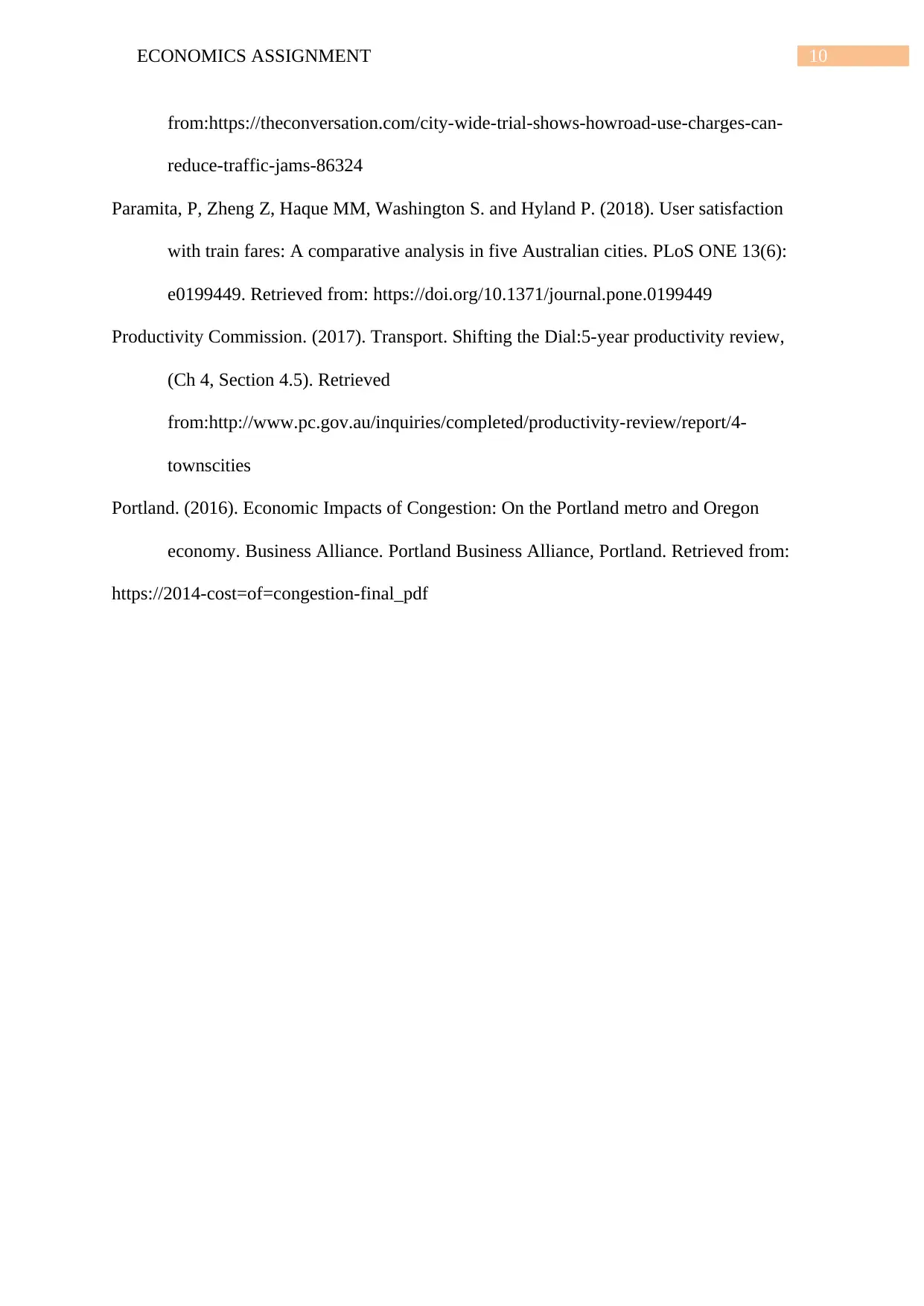
10ECONOMICS ASSIGNMENT
from:https://theconversation.com/city-wide-trial-shows-howroad-use-charges-can-
reduce-traffic-jams-86324
Paramita, P, Zheng Z, Haque MM, Washington S. and Hyland P. (2018). User satisfaction
with train fares: A comparative analysis in five Australian cities. PLoS ONE 13(6):
e0199449. Retrieved from: https://doi.org/10.1371/journal.pone.0199449
Productivity Commission. (2017). Transport. Shifting the Dial:5-year productivity review,
(Ch 4, Section 4.5). Retrieved
from:http://www.pc.gov.au/inquiries/completed/productivity-review/report/4-
townscities
Portland. (2016). Economic Impacts of Congestion: On the Portland metro and Oregon
economy. Business Alliance. Portland Business Alliance, Portland. Retrieved from:
https://2014-cost=of=congestion-final_pdf
from:https://theconversation.com/city-wide-trial-shows-howroad-use-charges-can-
reduce-traffic-jams-86324
Paramita, P, Zheng Z, Haque MM, Washington S. and Hyland P. (2018). User satisfaction
with train fares: A comparative analysis in five Australian cities. PLoS ONE 13(6):
e0199449. Retrieved from: https://doi.org/10.1371/journal.pone.0199449
Productivity Commission. (2017). Transport. Shifting the Dial:5-year productivity review,
(Ch 4, Section 4.5). Retrieved
from:http://www.pc.gov.au/inquiries/completed/productivity-review/report/4-
townscities
Portland. (2016). Economic Impacts of Congestion: On the Portland metro and Oregon
economy. Business Alliance. Portland Business Alliance, Portland. Retrieved from:
https://2014-cost=of=congestion-final_pdf
1 out of 11
Related Documents
Your All-in-One AI-Powered Toolkit for Academic Success.
+13062052269
info@desklib.com
Available 24*7 on WhatsApp / Email
![[object Object]](/_next/static/media/star-bottom.7253800d.svg)
Unlock your academic potential
Copyright © 2020–2026 A2Z Services. All Rights Reserved. Developed and managed by ZUCOL.



